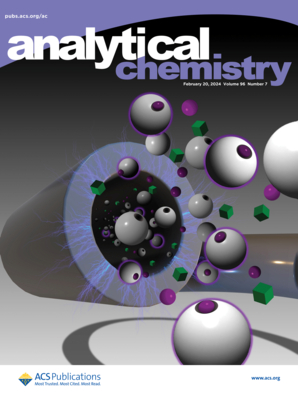Multiple Enzyme-Mimicking CuMOF-Driven Self-Cascading Antioxidant Reaction for Synergistic Electrochemiluminescence Modulation in Ultrasensitive Biosensing
IF 6.7
1区 化学
Q1 CHEMISTRY, ANALYTICAL
引用次数: 0
Abstract
Developing nanozyme-based free radical scavenging is a promising signal modulation approach for ECL sensing. Nevertheless, the relatively low antioxidant activity and inherent pro-oxidant activity of numerous nanozymes have significantly hindered the development of this strategy. Here a biofunctional copper-based metal–organic framework (CuMOF) with multiple enzyme-mimicking activities was employed for the modulation of the ECL immunosensor, guided by the self-cascade antioxidant reaction. The inherent SOD, CAT, and the capacity to eliminate ·OH endow CuMOF with powerful synergistic antioxidant effects while little pro-oxidant activities were displayed, enabling efficient scavenging of the O2·– produced during the electrochemical oxidation of H2O2. Subsequently, the nanoconfinement effect of the layered double hydroxide was introduced to ensure a steady ECL signal. The suggested ECL immunosensor, using aflatoxin B1 as a proof-of-concept target, demonstrated a detection range spanning from 0.001 pg/mL to 10 ng/mL, with the detection limit calculated to be 0.18 fg/mL. This exceptional achievement greatly broadens the range of possible uses for nanozyme-based radical scavenging modulated ECL analysis.多种酶模拟 CuMOF 驱动的自级联抗氧化反应用于超灵敏生物传感中的协同电化学发光调制
开发基于纳米酶的自由基清除技术是 ECL 传感技术中一种前景广阔的信号调制方法。然而,许多纳米酶的抗氧化活性相对较低,而且本身具有促氧化活性,这极大地阻碍了这一策略的发展。在此,我们采用了一种具有多种酶模拟活性的生物功能性铜基金属有机框架(CuMOF),在自级联抗氧化反应的引导下对 ECL 免疫传感器进行调制。固有的 SOD、CAT 和消除 -OH 的能力赋予了 CuMOF 强大的协同抗氧化作用,同时也显示出极少的促氧化活性,从而能够有效清除 H2O2 电化学氧化过程中产生的 O2。随后,引入了层状双氢氧化物的纳米强化效应,确保了 ECL 信号的稳定。建议的 ECL 免疫传感器以黄曲霉毒素 B1 为概念验证目标,其检测范围从 0.001 pg/mL 到 10 ng/mL,检测限为 0.18 fg/mL。这一卓越成就大大拓宽了基于纳米酶的自由基清除调制 ECL 分析的可能用途范围。
本文章由计算机程序翻译,如有差异,请以英文原文为准。
求助全文
约1分钟内获得全文
求助全文
来源期刊

Analytical Chemistry
化学-分析化学
CiteScore
12.10
自引率
12.20%
发文量
1949
审稿时长
1.4 months
期刊介绍:
Analytical Chemistry, a peer-reviewed research journal, focuses on disseminating new and original knowledge across all branches of analytical chemistry. Fundamental articles may explore general principles of chemical measurement science and need not directly address existing or potential analytical methodology. They can be entirely theoretical or report experimental results. Contributions may cover various phases of analytical operations, including sampling, bioanalysis, electrochemistry, mass spectrometry, microscale and nanoscale systems, environmental analysis, separations, spectroscopy, chemical reactions and selectivity, instrumentation, imaging, surface analysis, and data processing. Papers discussing known analytical methods should present a significant, original application of the method, a notable improvement, or results on an important analyte.
 求助内容:
求助内容: 应助结果提醒方式:
应助结果提醒方式:


